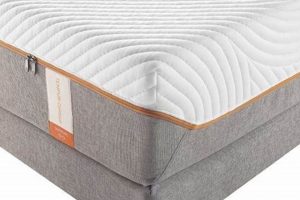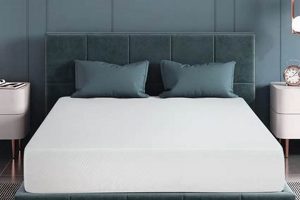These sleep surfaces combine viscoelastic foam with gel infusions or layers to offer a unique sleeping experience. Viscoelastic foam conforms to the body’s shape, providing pressure relief and support. The inclusion of gel aims to mitigate the foam’s tendency to retain heat, promoting a cooler sleep environment. This combination addresses common concerns related to traditional mattress materials.
The advantages of this design include enhanced comfort, reduced motion transfer, and potential alleviation of pressure points. The conforming properties of the foam contribute to spinal alignment, while the gel component can draw heat away from the body. Historically, manufacturers have sought to improve upon conventional foam mattresses by incorporating cooling technologies, leading to the development and refinement of gel-infused options. These improvements address the need for more comfortable and temperature-regulated sleep.
Understanding the specific types of foam and gel used, the construction methods employed, and the overall firmness level is essential when evaluating such products. Examining the density and thickness of the foam layers, as well as the distribution and type of gel, allows for a comprehensive assessment of its suitability for individual needs and preferences. Considerations regarding support, temperature regulation, and durability are paramount in making an informed decision.
Essential Considerations for Selection and Maintenance
Selecting and maintaining these products requires careful consideration to ensure optimal performance and longevity. These guidelines provide valuable insights for making informed decisions and preserving the integrity of such investment.
Tip 1: Assess Density and Thickness. The density of the foam impacts its durability and support. Higher density foam tends to be more resilient. Consider the thickness of the foam layers, as thicker layers often provide enhanced comfort and pressure relief.
Tip 2: Evaluate Gel Distribution. The distribution of gel within the mattress influences its cooling capabilities. Uniform distribution or strategic placement in areas prone to heat buildup can enhance temperature regulation.
Tip 3: Consider Support Core. The support core, often consisting of high-density foam or innersprings, provides the underlying support structure. Assess the core’s firmness and construction to ensure adequate spinal alignment.
Tip 4: Research Certifications. Look for certifications such as CertiPUR-US, which indicate that the foam has been tested for harmful chemicals and emissions. These certifications assure product safety and quality.
Tip 5: Implement Proper Care and Cleaning. Use a mattress protector to safeguard against spills and stains. Vacuum the mattress regularly to remove dust and allergens. Spot clean stains with a mild detergent and water solution.
Tip 6: Rotate Regularly. Rotate the mattress periodically, typically every six months, to promote even wear and prevent indentations. This practice extends its lifespan and maintains its support.
Tip 7: Allow for Ventilation. Ensure adequate ventilation around the mattress to prevent moisture buildup and mold growth. Use a breathable bed frame and avoid covering the mattress with airtight materials.
Adhering to these guidelines enhances the performance, comfort, and longevity of these products. Thoughtful selection and consistent maintenance practices contribute to a healthier and more restful sleep environment.
The following sections explore the specific benefits and drawbacks associated with various construction methods and materials used in their manufacture.
1. Conforming Support
Viscoelastic foam’s primary characteristic is its ability to contour to the shape of a body, providing conforming support. This occurs because the foam softens in response to pressure and heat, distributing weight evenly and minimizing pressure points. The inclusion of gel in these mattresses does not directly contribute to the conforming support; rather, it addresses temperature regulation, a common concern associated with the density of memory foam. The conforming support provided by the foam is crucial for spinal alignment, particularly for individuals with back pain or other musculoskeletal conditions. For example, a side sleeper’s hips and shoulders sink into the foam, maintaining a more natural spinal posture compared to a traditional innerspring mattress that may create pressure points.
The effectiveness of the conforming support depends on the foam’s density and thickness. Lower-density foam may not provide adequate support for heavier individuals, leading to sagging and discomfort. Similarly, a thin layer of foam over a firm support core may not offer sufficient contouring. Manufacturers often utilize different foam densities in various zones to provide targeted support to different areas of the body. For instance, firmer foam may be used in the lumbar region to maintain spinal alignment, while softer foam is used in the shoulder region to relieve pressure.
Understanding the relationship between conforming support and material properties is essential for selecting an appropriate sleep surface. Challenges remain in balancing support with temperature regulation, as denser foams, which offer superior support, tend to retain more heat. The integration of gel, open-cell foam structures, and other cooling technologies aims to mitigate this issue. Ultimately, the practical significance lies in improved sleep quality, reduced pain, and enhanced overall comfort, highlighting the importance of carefully considering the material composition and construction of this type of sleep product.
2. Temperature Regulation
The effectiveness of temperature regulation in these mattresses represents a significant factor in overall sleep comfort. Viscoelastic foam, by nature, possesses a dense structure that can impede airflow and trap heat. The inclusion of gel, either infused within the foam or layered on top, aims to counteract this inherent limitation. The cooling effect stems from gel’s ability to absorb and dissipate heat, thereby creating a more thermally neutral sleep surface. The quantity, distribution, and type of gel employed all influence the degree of temperature regulation achieved. For instance, open-cell foam infused with phase-change gel offers enhanced breathability and heat dissipation compared to traditional closed-cell foam with a simple gel layer. Insufficient temperature regulation can lead to overheating, discomfort, and disrupted sleep patterns, especially in warmer climates or for individuals prone to night sweats. Therefore, this is a crucial attribute.
Manufacturers employ various strategies to optimize temperature regulation. Open-cell foam structures allow for greater airflow, facilitating the removal of heat. Phase-change mate
rials embedded within the gel actively absorb and release heat, maintaining a more consistent temperature. Some mattresses incorporate ventilation channels or perforations to further enhance airflow. The practical application of these technologies involves selecting a mattress suited to individual thermal preferences and environmental conditions. Individuals who tend to sleep hot may benefit from mattresses with advanced cooling features, while those less sensitive to temperature may find a standard design sufficient. Independent testing and customer reviews can provide valuable insights into the actual performance of different cooling technologies.
The pursuit of effective temperature regulation in viscoelastic foam products remains an ongoing area of development. While gel infusions offer a tangible improvement, they do not entirely eliminate the potential for heat retention. Challenges persist in balancing the conforming support properties of memory foam with the need for adequate airflow and heat dissipation. Future innovations may involve the integration of more advanced materials and technologies to achieve superior thermal management. The practical significance of these advancements lies in providing a more comfortable and restorative sleep environment, regardless of external factors or individual physiological characteristics, which in turn contributes to improved health and well-being.
3. Pressure Relief
Pressure relief is a primary benefit associated with memory foam and gel mattress designs. The viscoelastic properties of the foam, coupled with the potential cooling effects of gel, contribute to a reduction in pressure points, promoting comfort and potentially alleviating pain.
- Conforming to Body Contours
Memory foam’s ability to mold to the body’s shape distributes weight more evenly compared to traditional innerspring mattresses. This conformity minimizes pressure on bony prominences such as hips, shoulders, and knees. By reducing concentrated pressure, circulation can improve, potentially reducing the incidence of tossing and turning during sleep. For example, an individual with arthritis may experience less joint pain due to the reduced pressure exerted on affected areas.
- Viscoelasticity and Impact Absorption
Viscoelastic materials exhibit both viscous and elastic characteristics. This means that memory foam slowly deforms under pressure and then returns to its original shape when the pressure is removed. This property allows the material to absorb impact and distribute it across a wider area, reducing localized pressure. A practical implication is that the mattress isolates motion, minimizing disturbance to a sleeping partner when one person moves.
- Gel Infusions and Pressure Redistribution
While gel primarily addresses temperature regulation, some gel formulations also contribute to pressure relief. Gel-infused foam can provide a slightly softer surface feel, enhancing the conforming properties of the foam. Furthermore, the gel may redistribute pressure more effectively than foam alone, particularly in areas of high compression. An example of this is a heavier individual experiencing greater comfort due to the enhanced pressure redistribution capabilities of the gel.
- Zoned Support Systems
Many memory foam and gel mattresses incorporate zoned support systems. These systems utilize varying densities of foam to provide targeted support and pressure relief to different areas of the body. Firmer foam may be used in the lumbar region to support the lower back, while softer foam is used in the shoulder and hip regions to relieve pressure. This targeted approach ensures optimal spinal alignment and reduces pressure points, contributing to improved sleep quality.
The facets of conforming support, viscoelasticity, gel infusions, and zoned support systems collectively enhance pressure relief capabilities. The effectiveness of this type of mattress in reducing pressure points depends on factors such as foam density, gel composition, and the overall construction. Individuals seeking significant pressure relief should carefully consider these factors when selecting a sleep surface. The practical benefit is that effective pressure relief contributes to improved sleep quality, reduced pain, and enhanced overall well-being.
4. Motion Isolation
Motion isolation, a key characteristic of viscoelastic foam and gel-infused mattress designs, refers to the mattress’s ability to minimize the transfer of movement from one area of the sleep surface to another. This property is particularly relevant for couples or individuals who share a bed, as it reduces the likelihood of being disturbed by a partner’s movements during the night. The viscoelastic nature of the foam, which absorbs and dissipates energy rather than transmitting it across the mattress, is the primary mechanism behind this effect. The gel component contributes indirectly, primarily by enhancing comfort and potentially dampening vibrations, but the core function of motion isolation resides within the foam itself. For example, if one partner gets out of bed or shifts positions, the movement is largely contained to that area, leaving the other partner undisturbed. This contrasts sharply with traditional innerspring mattresses, where movement tends to propagate across the entire surface.
The effectiveness of motion isolation is influenced by several factors, including the foam density, thickness, and the presence of distinct support layers. Higher-density foam generally provides better motion isolation, as it absorbs more energy. A thicker layer of foam also enhances this effect. Furthermore, some mattresses incorporate specialized transition layers designed to further dampen movement. Practical applications of this feature extend beyond mere convenience. Reduced sleep disturbances can lead to improved sleep quality, reduced stress levels, and enhanced overall well-being. Individuals who are light sleepers or who have partners with restless sleep habits may particularly benefit from the motion isolation properties. The significance of the motion isolation feature is underscored by its direct impact on sleep disruption, a major factor influencing quality of life.
In conclusion, motion isolation is a valuable attribute conferred by the composition and construction of memory foam and gel-infused mattress designs. This function’s ability to minimize sleep disturbances due to movement highlights the practical significance for couples and light sleepers. By absorbing and dampening energy, these mattresses promote more restful and uninterrupted sleep cycles. While ongoing advancements focus on further optimizing temperature regulation and support, motion isolation remains a core advantage, impacting the overall user experience and perceived value. Challenges in development often center around balancing motion isolation with other desired features like edge support and breathability, requiring careful design and material selection.
5. Density Variance
Density variance in memory foam and gel mattresses is a critical factor influencing support, comfort, and durability. The term refers to the differing densities of foam
used within various layers of the mattress. This is not a uniform characteristic; rather, manufacturers strategically vary density to achieve specific performance goals. High-density foam generally offers greater support and resistance to compression, while lower-density foam provides a softer, more contouring feel. For example, a typical design might incorporate high-density foam in the core for structural support and lower-density foam in the comfort layers to enhance pressure relief. This variance directly affects the mattress’s ability to properly align the spine, distribute weight, and minimize pressure points. Without careful consideration of density variance, the mattress may be either too firm, leading to discomfort, or too soft, resulting in inadequate support and potential sagging over time.
The practical applications of understanding density variance are significant for consumers. A heavier individual, for instance, would likely benefit from a mattress with a higher overall density and strategically placed high-density zones to prevent excessive sinking. Conversely, a lighter individual may find a mattress with lower overall density more comfortable. Zoned support systems, where different sections of the mattress are engineered with varying densities, exemplify the application of density variance. These systems often feature firmer foam in the lumbar region for lower back support and softer foam in the shoulder and hip regions for pressure relief. This targeted approach optimizes comfort and support for a wider range of body types and sleeping positions. By understanding the density specifications and the rationale behind their placement, consumers can make more informed decisions based on their individual needs and preferences. Furthermore, understanding density variance can aid in assessing the long-term durability and potential for sagging, a key consideration in mattress longevity.
In summary, density variance is a fundamental engineering aspect of memory foam and gel mattresses. Its careful manipulation allows manufacturers to fine-tune the mattress’s performance characteristics, optimizing support, comfort, and durability. The challenges involve balancing these various factors to create a mattress that suits a broad range of individuals. Recognizing the importance of density variance and its impact on performance empowers consumers to make informed choices, leading to improved sleep quality and overall satisfaction. Future advancements in mattress technology will likely continue to leverage density variance to create increasingly personalized and high-performing sleep surfaces.
6. Material Durability
Material durability is a critical attribute impacting the longevity and performance of memory foam and gel mattresses. The lifespan of such a product is directly proportional to the quality and resilience of the constituent materials. Degradation of foam, compression set (permanent indentation), and breakdown of gel components can significantly diminish the mattress’s support, comfort, and temperature regulation capabilities over time. For instance, a low-density memory foam may exhibit significant sagging within a few years of use, compromising spinal alignment and pressure relief. The practical significance of understanding material durability lies in making informed purchasing decisions and minimizing the long-term cost of ownership. A mattress with superior material durability, though potentially more expensive initially, offers a more extended period of consistent performance, preventing premature replacement and ensuring lasting comfort.
Several factors influence material durability. The density of the memory foam is paramount; higher densities generally indicate greater resistance to compression and a longer lifespan. The type and quality of gel used also play a role; some gel formulations are more prone to degradation or displacement than others. The presence of reinforcing layers or support cores can further enhance durability by providing additional structural integrity. Certifications such as CertiPUR-US ensure that the foam has been tested for harmful substances and meets certain durability standards. Furthermore, proper care and maintenance practices, such as using a mattress protector, rotating the mattress regularly, and avoiding excessive weight or pressure, can extend its lifespan. Real-life examples demonstrate the tangible impact of material choices; a mattress constructed with high-density foam and a durable support core may last for ten years or more, while one made with low-quality materials may require replacement within a much shorter timeframe.
In conclusion, material durability is an indispensable consideration when evaluating memory foam and gel mattresses. The quality of materials directly impacts the mattress’s ability to provide consistent support, comfort, and temperature regulation over its intended lifespan. While initial cost is a factor, prioritizing material durability ensures a better long-term investment, preventing premature replacement and maximizing overall value. The challenges lie in accurately assessing material quality and predicting long-term performance, highlighting the importance of researching manufacturer specifications, reading customer reviews, and seeking independent certifications. This focus on durability aligns with the broader theme of sustainable consumption and responsible purchasing, emphasizing the importance of selecting products that are built to last.
Frequently Asked Questions About Memory Foam and Gel Mattresses
This section addresses common inquiries regarding memory foam and gel mattresses, providing factual information to aid in informed decision-making.
Question 1: What is the typical lifespan of a memory foam and gel mattress?
The lifespan of such a product varies depending on material quality, density, and usage. Generally, a well-maintained mattress can last between 7 to 10 years. Higher density foams and robust construction contribute to extended longevity.
Question 2: Are these mattresses suitable for all sleeping positions?
While adaptable, their suitability depends on firmness and support characteristics. Side sleepers often benefit from the pressure relief. Back sleepers require adequate lumbar support. Stomach sleepers may need a firmer model to prevent excessive sinking.
Question 3: How effective is the gel component in regulating temperature?
The gel infusion aims to mitigate heat retention, a common concern with memory foam. Effectiveness varies based on gel type, distribution, and overall mattress construction. Open-cell foams and phase-change materials offer enhanced cooling capabilities.
Question 4: What is the ideal density for a memory foam and gel mattress?
Ideal density depends on individual weight and comfort preferences. Higher density foams provide greater support and durability, typically recommended for heavier individuals. Lower density foams offer a softer feel, suitable for lighter individuals.
Question 5: How should these mattresses be cleaned and maintained?
Regular vacuuming is recommended to remove dust and allergens. Spot clean stains with a mild detergent and water solution. Using a mattress protector safeguards against spills and damage. Rotating the mattress periodically promotes even wear.
Question 6: Do these mattresses emit any harmful chemicals?
Mattresses certified by organizations such as CertiPUR-US are tested for harmful chemicals and emissions. Look for these certifications to ensure product safety and
quality.
In summary, careful consideration of material quality, density, and construction is crucial when selecting a memory foam and gel mattress. Proper maintenance extends lifespan and preserves performance.
The following section delves into the various types of memory foam and gel technologies available.
Concluding Remarks on Memory Foam and Gel Mattress Technology
The preceding exploration of memory foam and gel mattress designs has illuminated key characteristics, including conforming support, temperature regulation, pressure relief, motion isolation, density variance, and material durability. Understanding these aspects is crucial for consumers seeking informed purchasing decisions. While memory foam and gel mattress combinations offer potential benefits, their suitability is contingent upon individual needs and preferences. Considerations regarding body weight, sleeping position, and thermal sensitivity should guide the selection process.
The continued evolution of materials and manufacturing techniques promises further advancements in sleep surface technology. Future research may focus on optimizing temperature regulation, enhancing durability, and personalizing support characteristics. As consumers navigate the increasingly complex landscape of mattress options, a thorough understanding of the underlying principles will remain paramount in achieving optimal sleep quality and long-term satisfaction.


![Best Memory Foam Camper Mattress [Deals!] Organic & Natural Mattress Buyer’s Guide: Non-Toxic Sleep Solutions Best Memory Foam Camper Mattress [Deals!] | Organic & Natural Mattress Buyer’s Guide: Non-Toxic Sleep Solutions](https://mattressworldpa.com/wp-content/uploads/2025/07/th-4035-300x200.jpg)

![Best Memory Foam Futon Mattress for Comfy Sleep [Guide] Organic & Natural Mattress Buyer’s Guide: Non-Toxic Sleep Solutions Best Memory Foam Futon Mattress for Comfy Sleep [Guide] | Organic & Natural Mattress Buyer’s Guide: Non-Toxic Sleep Solutions](https://mattressworldpa.com/wp-content/uploads/2025/07/th-4033-300x200.jpg)


